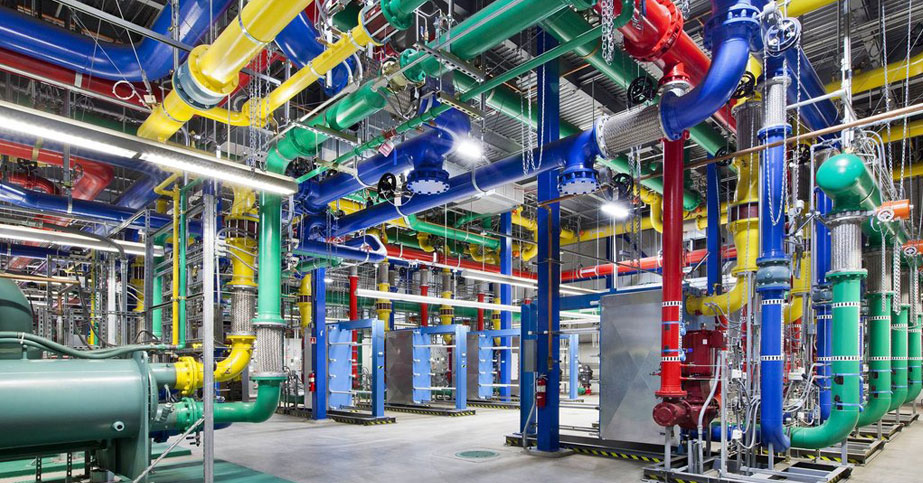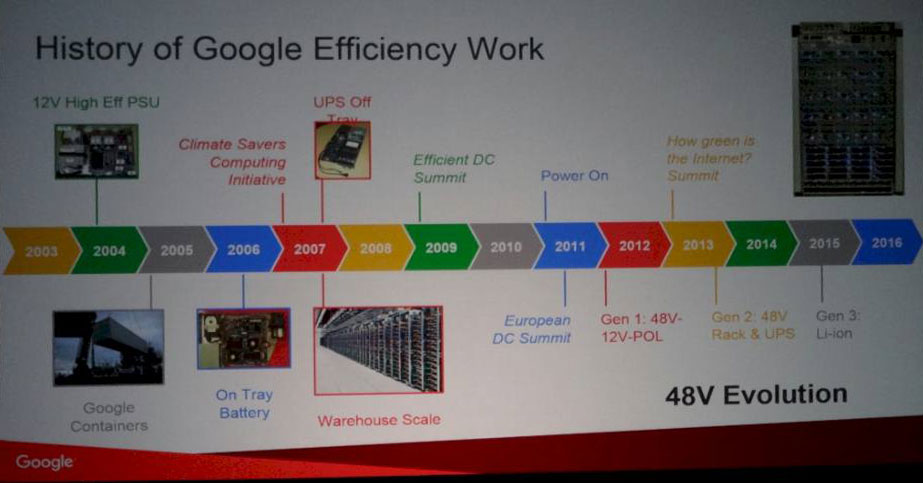 The search giant Google announces that it's joining the Open Compute Project (OCP), an initiative by Facebook and a number of other companies that aims to drive IT infrastructure development forward through open-source hardware.
The search giant Google announces that it's joining the Open Compute Project (OCP), an initiative by Facebook and a number of other companies that aims to drive IT infrastructure development forward through open-source hardware.
As for Facebook part, the company has open-sourced how it builds some of its servers and some of its data center hardware.
The social network giant Facebook founded the OCP in 2011 to share designs of servers and other data center equipment. Many companies have joined the project and contributed their hardware designs. Google has been building its own hardware for many years, and it hasn't joined the project until now.
During those years, Google did shared some information to the public about how it powers its data centers. But it kept most of its secret to its own. Now it has signed on with Facebook and others to work as a team on the OCP Open Rack project. As for Google's part, the company aims to bring 48 volt power distribution to data center racks.
Google says that it has been working on 48V rack power distribution for quite some times and saw it to be more efficient if compared to its previous systems.
"In 2009, we started evaluating alternatives to our 12V power designs that could drive better system efficiency and performance as our fleet demanded more power to support new high-performance computing products, such as high-power CPUs and GPUs," wrote Google. "We kicked off the development of 48V rack power distribution in 2010, as we found it was at least 30 percent more energy-efficient and more cost-effective in supporting these higher-performance systems."
Google said that it has deployed thousands of the racks in its own data centers.
"The key thing that we figured out was, to get the efficiency in cost and power, you have to directly feed the 48 volts to the motherboard and convert it only in one step," said Google's senior vice president of the Technical Infrastructure team Urs Hölzle at the 2016 OCP Summit. "So these workloads have only one AC-to-DC transformation step, and you step down the 48 volts - for example, at the CPU - to around 1 volt."
Machine learning is one area that requires higher-power workloads. Google that has been using its 48V systems for year, said that it's now comfortable enough with the design and reliability to share it with the world.
"As the industry's working to solve these same problems and dealing with higher-power workloads, such as GPUs for machine learning, it makes sense to standardize this new design by working with OCP," said Google's Technical Program Manager John Zipfel in the announcement. "We believe this will help everyone adopt this next generation power architecture, and realize the same power efficiency and cost benefits as Google."

Teaming The Giants
During the Open Compute Summit 2016 conference, Google's Urs Hölzle, joined Facebook's Vice President of Engineering Jay Parikh, on the stage and announced that Google was joining the open hardware effort.
While Google is the newest member on the project, there was practically nothing that prevented Google from joining at any in the past few years, Except the fact that its infrastructure is already strategic to its business operation and profitability so it constantly run on scaling issues. But despite being quiet all this time, the company knows that it can benefit from cooperation in the industry by joining others to drive up innovations while driving down costs.
Back in 1999, Google's first ever rack-scale system was called the Corkboard cluster that consisted of 1,680 custom-made machines. Designed by Hölzle, the system increased its infrastructure footprint by more than 15 times. This huge advantage has given the company a promising path towards hyperscale computing as its search engine went popular along with the commercial internet.
As with any companies, Google took out any outdated components from its systems that were seen unnecessary. In 2005 when the company started to custom its own machines, it put batteries in servers so it could get rid of uninterruptible power supplies out of the data center. This was also done by Microsoft after it joined OCP, a decade after Google had done it.
At Google, Hölzle is obsessive about driving up efficiency in the company’s data centers to put down operational costs. Back in 2003 at CERN, he discussed the need for the industry to deliver more efficient power supplies, which wasted a lot of energy at the time.
It was in 2004 when Google moved to 12V power supplies. In 2006, it integrated 12V batteries in the power supplies on a distinct power shelf in its racks to allow servers to share these components. Since that time, Google has made numerous kinds of power and cooling innovations in the data center which it does not generally disclose.
Having its 12V power distribution perfected to gear inside the rack, Google started to think how it could push efficiencies even further. To accomplish that attempt, Google brought a higher voltage to the rack. After some experiments, the company found that a 48V power distribution was the answer to its efficiency question.
After knowing that, Google started a number of different designs: 48 volts at the rack and 12 volts at the server, and 48 volts into the rack and then direct conversions to specific voltages for elements of the motherboard.
The 48V rack is much more efficient that a highly tuned 12V rack. While a single system may not matter much, but for Google that has 25 megawatt data centers, that is certainly a big deal.
While this was a breakthrough for Google, the company met a big problem: there is no 48V rack standard. By joining the OCP, Google wants to set that standard along with other tech companies in the community. What Google is presenting to the project, is shallower than a standard server rack. The OCP's current rack design is too deep for the narrow aisles in Google's data centers, Hölzle said, so Google's specification calls for a rack that's a bit shallower.
He said standard server equipment still fits in the smaller racks.
Hölzle said that what compelled Google to join the Open Compute effort was the desire to push efficiencies in the last six feet of power distribution inside of a rack and the last ten inches of power distribution on a server motherboard. The company wants for there to be one standard for 48V racks, and the idea is that server designs will be able to work with both the proposed Google rack and the current Open Rack from Facebook.

A Rack And More To Come
As the first step in engaging with the OCP, Google also plans to continue to explore additional OCP project areas for future engagement. The company said that it wants to work with the OCP on "disk solutions for cloud-based applications" and new software for server and network management capable of hyperscale computing.
For example, Google wants to develop an alternative to SNMP (Simple Network Management Protocol), which has been the standard for sharing operational data about equipment in data centers, such as temperatures and fan speeds.
Although the rack design probably won't be the last contribution Google makes to the OCP. Though Google didn't say anything about revealing its server designs.
Google isn't the only company making moves towards the OCP. Software giant Microsoft which became a member of the project since 2014, has made an announcement that it, along with Arista, Broadcom, Dell and Mellanox, is contributing a number of networking components with its intentions to make servers more efficient.
It's something relatively new to see tech giants to share and help one another. What they do, at their scale, is aiming to set a better standards together that will benefit everyone.